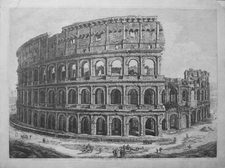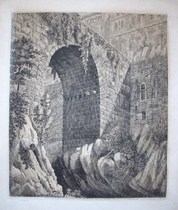Luigi Rossini (1790 - 1857) was an Italian architect, engraver and watercolorist. His first series of views were published in 1814. He began his Roman antiquities series in 1819, completing 101 large folio plates which were published in Rome in 1825. His etchings on paper were popular souvenirs among the wealthy tourists of the time visiting the historical beauties of Italy on the Grand Tour. Like his predecessor Giovanni Battista Piranesi, Rossini focused on antique Roman architecture and excavations in Rome and its surrounding countryside and rendered in exquisite detail the beauty of classical Rome. In contrast to Piranesi, he made greater use of the bucolic settings in his etchings of Roman ruins. His images of the architectural masterpieces of ancient Rome, including the Pantheon, the Colosseum, the Appian Way, and the Golden House of Nero Emperor, have greatly influenced architects, artists, writers, and other connoisseurs of Roman culture up to the present day.

|

|


